
Home
Privacy, Terms & Conditions
Occasional Papers
Ancient Mysteries
BOOKSHOP
Epsom and Ewell Waters
Archives/Reviews
Awards Gallery
Destiny
Malvern Waters and Malverns Worldwide
Somerville Diaries
Grotto News
Grotto Essays
Grotto.DirectorySpas Research Fellowship Archives, Library, Book Reviews. Search our online specialist Spa Gazer Archives and Bibliography by inserting a key word or publication year; alternatively scroll down to see our Book Reviews of recently published spa books
about the archives....
There are several major private collections of publications on spas, mineral waters and related subjects as well as the National Collections in the British Library and elsewhere. Some of the private collections hold material not available elsewhere.
The SRF has direct access to various collections, the scope of which can be ascertained from the search facility above. Scholars researching this subject area will find this facility an excellent starting point for a bibliographical investigation.
We are pleased to answer simple queries on relevant texts. We separately maintain a database of locations referred to in pre 19th century works, which is a useful aid to identifying the whereabouts of early source material. Associates, Institutional Members and Fellows of the SRF have regulated access to these collections and databases.
The SRF is always seeking to extend the collections and we are pleased to consider the acquisition by purchase of works not listed. In addition we are pleased to review books and then feature these reviews on our web site, in exchange for an archive copy.Book Reviews
Roger Rolls (2012) Diseased, Douched and Doctored. London Publishing Partnership ISBN 978-1-907994-09-8 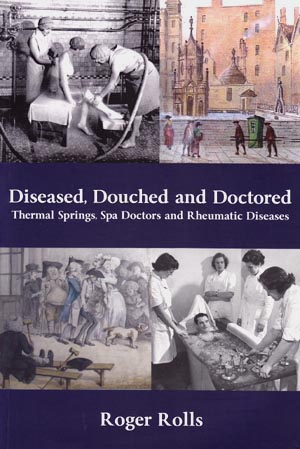
This is a thought-provoking book that solicits the question: is this the record of the demise of a branch of medicine that was once held in great esteem?
The essence of a good book is that it produces new observations and findings rather than just regurgitates the writings of others. Achieving this entails original research using archive documents, field work, archaeology, etc. Roger Rolls' new book achieves this and thus extends the scope of our understanding of the application of thermal waters for health, particularly at Britain's unique thermal spa Bath. The book is fully referenced and indexed and contains 245 printed pages with soft covers. The size is 16.4 cms. x 24.5 cms. It is profusely illustrated, with many pictures in full colour.
Dr. Roger Rolls, as a medical historian, was particularly active during the 1990s with the British Spas Federation, promoting well-being through the application of spa waters. This era was decisive for the spa industry laying the foundation for the 21st century spa revival in the UK. Today we can see how the industry has evolved and Roger Rolls leaves the reader thinking that an opportunity has been missed.
Diseased, Douched and Doctors traces the utilisation of thermal spring waters for healing since the Romans, concentrating on the 17th to 19th century period when spas as a branch of medicine were in their heyday. It focuses on the waters of Bath, which are unique in the UK. It also touches on the tepid waters of Buxton, Matlock and Bristol. Detailed examples are given of the wide variety of treatments on offer over the centuries and their effects. This is of special interest to anyone wishing to investigate the former merits of spa treatments in medicine; and also the problems, such as contamination of communal bathing waters by the sick. Of particular interest are the historic pictures of people showing physical symptoms such as limp limbs and swollen joints.
The changing fashion for different treatments is apparent, particularly as new technologies become available such as electricity. The case is cited of the pioneering use of electricity for healing at Worcester Cathedral in the 18th century. 'Perhaps it was the ethereal quality of electricity which rendered it attractive to ministers of religion' .(page 47) Such practices were readily integrated into the range of treatments available for 'the cure' at Bath's healing water establishments.
In spite of enthusiasm for new gadgets, important research opportunities were missed. The Bath Mineral Water Hospital was noted for its treatment of rheumatism, one of the long lasting conditions that had defied the other two main areas of medicine historically, the surgeon's knife and drugs. In spite of the high number of patients, little innovation was apparent over the years at Bath, leaving the way open for the other alternatives to develop effective treatments. Prevention also challenged Bath's cure regimes. Lead poisoning was effectively treated at Bath up to the 19th century. However recognition as to its causations eliminated much of the problem and the Bath water cure became obsolete.
When reading the book and comparing England with European spas where medical treatments are still practiced, one can not help wondering if we have missed an opportunity for mineral water cure development, especially as it is less invasive than drugs or less irreversible than the knife? In England the sun is setting on spa waters as a serious branch of orthodox medicine. Even the Thermae Bath Spa, opened in 2006, concentrates on leisure and pleasure experiences, leaving the cure to mainstream medicine via the National Health Service.
For anyone interested in the history of medicine or the use of source waters, this book is a must that will extend their understanding of the history and development of a branch of medicine that has all but disappeared in England.
Available at £19.99 from Central Books, 99 Wallis Road, London E9 5LN, UK. Tel: +44(0)845 458 9911.
Trade orders email: orders@centralbooks.com
SUPPLEMENTARY COMMENT
Today we still see new concepts emerging in the use of natural waters such as water with a memory. Do these genuinely open new doors for the industry or is it a desperate attempt to stay afloat on a sinking ship? Perhaps Malvern Spa has found the answer. As a result of initiatives taken by a small number of people in the early 1990s, Malvern springs and wells are now an internationally recognised tourism attraction, ironically purveying health to the visitors as they exercise by walking the famous hills in search of the many water features. See www.malvernwaters.co.uk
Dr Bruce E Osborne, Spas Research Fellowship, February 2012.Stout A. The Thorn and the Waters – Miraculous Glastonbury in the Eighteenth Century (2007 this edition 2008) Green and Pleasant, Somerset.
Presented as an A5 paperback, this 64 page book exhibits a quality of research and intellectual debate that sets it above the run-of-the-mill local history publication. This is therefore more likely to be of interest to the serious scholar of the development of holy wells and mineral water spas than to the casual visitor to Glastonbury. The related discussion on the religious conflicts that are a feature of the town also means that those interested in the clash of belief systems will find this worthy of reading.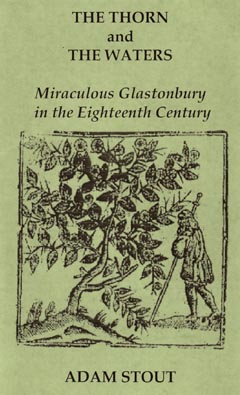
What Stout does is to discuss the development of the holy well/spa cult in Glastonbury during the mid 18th century against the backcloth of the more esoteric and mystical beliefs that surround the towns heritage. It is noted that somewhere between the extremes of modern market town and mythological centre there lies a common sense understanding of the mid 18th century phenomenon of the discovery and exploitation of the healing waters. Stout does note however that the "facts" are just another form of fiction.
Authors have been undecided about how far back the mysticism that surrounds Glastonbury goes. Was it a 19th century creation or does it date from the Reformation when the destruction of the religious establishment there took place in such a dramatic way? In seeking to put Glastonbury in such a rationale context however is Stout in danger of destroying precisely what is valuable? When there is no mystery, the ethos of Glastonbury disintegrates. Stout would deny that his writings do this, instead arguing that Glastonbury is shown to have had "a certifiably unusual reputation" even in the highly-rational eighteenth century.
Matthew Chancellor promoted his discovery of the waters in 1751 and like many other aspects of Glastonbury, this was seen as a way forward. Legends and antiquity were similar promotional platforms that would perhaps lead to enhancement of the local tourist trade. A Pump Room opened in 1753 thus enhancing the facilities. The vital water source was that of the Chaingate Spout, which was fed from six sources including the celebrated Chalice Well. Bottling of the mystic elixir for the capital also enhanced the exploitation of the newly discovered waters. Stout quotes the case of the vicar; even he boarded strangers who visited the town to take the waters.
Like many newly discovered spas, the adventurous tried the waters and moved on to the next fashionable resort, disappearing as fast as they had miraculously appeared. This left the waters to be taken by the poor who could not travel and the infrastructure becoming ruinous. Inevitably the question arose: was the reputation of the waters based on a combination of religious association and often questionable testimony perhaps trumped up to fuel the tourist trade?
The parallel case of the Glastonbury Thorn reputedly flowering on Christmas day is considered at some length; especially in the light of the loss of 11 days in the calendar in 1752 to provide wide spread uniformity. This in itself attracted tourists to the town to observe the holy tree perform on the new Christmas day or perhaps 11 days later. Inevitably in attempting to rationalise the fervor, both for tree and water, the Catholic and Protestant debate imposes itself on the arguments and Stout attempts to navigate his way through this.
As time progresses the repute and low level patronage of the Glastonbury waters endured through to the nineteenth century but it was not as an enterprising spa town that continually reinvented itself. Glastonbury slipped into a backwater as England industrialised. It was left with its mythology and legend and a blighted religious ethos to provide a dynamo to interest tourists of all types and beliefs. The Holy Well became an integral part of this for a while.
As a spa historian I found the book an absorbing read with an impressive list of source works quoted. The fact that there is no title page was slightly disconcerting and I would have found an index useful. Do not be put off by this however.
Dr Bruce E Osborne, Spas Research Fellowship, February 2009.
Cover price £4.96. To purchase direct, the book is available from Adam Stout at 6 Redland Terrace, Frome, BA11 1HT, Somerset UK, £4.96 + £1p+p; please contact Adam first on adam.stout@virgin.net if you're ordering from foreign parts; cheques payable to “Adam Stout”.
English Holy Wells – a sourcebook – Harte J (2008) Heart of Albion Loughborough.
Directly one reads the sub title it is immediately apparent by the pun that Jeremy’s sense of humour is going to lift this mammoth tome from a barely digestible detailed academic diatribe on an obscure subject into something that entertains as well as informs the reader. This is a book that comes in three volumes. Volumes two and three are a detailed gazetteer of English Holy Wells and is the most comprehensive ever put together for publishing. Volume one is a discussion on the origins of Holy Wells and provides not only a critique of theories expounded by scholars earlier but proposes eighteen different scenarios that have led to the creation of Holy Wells in England. Volume one comes with numerous black and white illustrations within the text.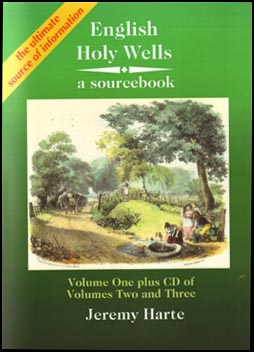 As Jeremy indicates in the introduction, one has to appreciate that there are many different types of Holy Well and any effort to collectively assign them to a common origin suffers from “a radical foreshortening of the historical perspective”. The case of “sacred stones” is cited arguing that one can similarly not indiscriminately jumble war memorials, megaliths, tombstones, crosses, obelisks and altars into the same box. It is also pointed out that unlike many religious edifices, Holy Wells are merely water sources and often are bereft of architecture instead relying on documentary evidence to establish their provenance. As is later shown in the text the surviving literature can be misleading to say the least, often as a result of embellishment of the legend over time for a variety of reasons.
As Jeremy indicates in the introduction, one has to appreciate that there are many different types of Holy Well and any effort to collectively assign them to a common origin suffers from “a radical foreshortening of the historical perspective”. The case of “sacred stones” is cited arguing that one can similarly not indiscriminately jumble war memorials, megaliths, tombstones, crosses, obelisks and altars into the same box. It is also pointed out that unlike many religious edifices, Holy Wells are merely water sources and often are bereft of architecture instead relying on documentary evidence to establish their provenance. As is later shown in the text the surviving literature can be misleading to say the least, often as a result of embellishment of the legend over time for a variety of reasons.
The value of English Holy Wells as an authoritative publication is threefold. Firstly it is a gazetteer of sources and their recording over the centuries and as such is a prime reference point for anyone wishing to locate and conduct further research on particular sites. The bibliography in particular gives students of Holy Wells a substantial guide with regard to source material. Secondly through distribution analysis, clarity is given to regional variations and origins although in spite of the substantial database of over 900 sites, sub samples are inevitably in danger of falling below levels where significance is indicative rather than totally reliable. Thirdly this publication debunks many theories that have been postulated over time about individual sites and general history of Holy Wells and as such sets a new standard and framework for scholarly research into the subject.
With a personal interest in Great Malvern it is interesting to note how Jeremy weaves the critical points from many years of historical research into his overall hypothesis. As such it is apparent that English Holy Wells is not a stand alone work of historical research. What we have is building blocks of countless authors and historians over the centuries consolidated into a single work of immense size and significance. As such it is able to draw conclusions on a macro level. For the fine detail of specific sites the scholar then needs to refer back to the source material. Clues are given as to relevant recent local research findings and in the case of Malvern, the provenance of St Ann’s Well as a name is comparatively recent with a possible much earlier association with St Werstan, the martyr founding saint of the religious cell. Such a clue gives direction to students seeking more detail.
For the computer orientated, volumes two and three are summarised on a cd that comes bound within volume one. The cd also contains the spreadsheet that summarises site characteristics. As such this publication is an essential reference guide for all serious enthusiasts of Holy Wells. It is also an ideal starting point for local research appertaining to specific sites. This makes it invaluable to the local historian, who can then consider the local scenario in the context of the overall Holy Well cult.
Dr B E Osborne (bruce@thespas.co.uk) 2009Davis and Bonsall P. A History of Bath – image and reality (2006) Carnegie Publishing.
Bath is one of those locations which have such a rich history that it has absorbed the attention of historians over thousands of years. With such attention can there be anything further to research and publish that has not already been extensively covered? Davis and Bonsall in A History of Bath clearly demonstrate that the answer is yes. History is continually being added and this book brings the reader right up to date with recent events. Also many historians specialise within a subject area and their work enables the overall picture to be adjusted as new facts are discovered and interpreted. A History of Bath brings the reader the modern day interpretation in the context of the overall panorama of Bath’s history since prehistory to present. And then there are advances in technology, not available to past historians. The authors use computer technology and modern publishing methods with magnificent and prolific full colour illustrations to produce an outstanding work.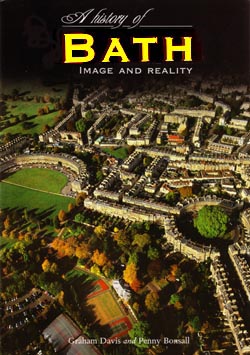
Davis and Bonsall chronologically take the various eras in the history of the spa town: Roman Spa, Saxon Monastic Town, Norman Cathedral City, etc. to provide the reader with a detailed picture of each. The inclusion of the likely layout of the Roman Baths and Temple complex is where recent archaeology enables the reader to appreciate what this central area may have been like. In this way each chapter is a component of an overall panorama of history. As such it is ideal for the student or scholar, using it as a platform for further specialised study. Such use is enhanced because the book is well referenced and the authors have used a mix of primary and secondary sources to great advantage.
Many of the subjects dealt with are relevant to the present day. Water shortage, a current, topical item on the news, is nothing new. Pages 235/7 outline Bath’s problems in the mid 19th century and this was before global warming was a recognised issue. Many of the scenarios are still developing. The new spa complex, a glass cube in the centre of a bath stone city of Georgian architecture is detailed and illustrated on page 301. This controversial development is now just open after many years of over budget expenditure, legal wrangle and delay. The launch of A History of Bath is most timely therefore. Some will argue that the new Spa development is a furtherance of the destruction of Georgian Bath carried out in the 1970s and detailed on page 290. It is still to be determined whether public opinion in the future will see this as an ill-conceived waste of time and money or whether the Spa will eventually take a real role in the ethos and appeal of the city. No doubt the second edition of this book will have something to say on this as history is evolved. Future historians will reinterpret the new Spa as we now do the role of William Smith, father of geology, with his work on the Somerset Coal Canal detailed on page 11. Interestingly it was Smith who laid the basis for Darwin’s theory of evolution though the fossil record as well as throwing light on the complex geology that gives rise to Bath’s thermal springs. It can be seen that Davis and Bonsall have produced a work that endlessly gives interesting insights on innumerable aspects of Bath that for many have gone unnoticed or forgotten.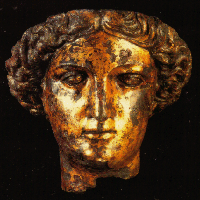
So who does A History of Bath appeal to? This is a substantial book of 335 printed pages and illustrations. It is not a quick read. For anyone interested or involved in the heritage of this health resort it is a “must have” item. Also of course the gift of such a book will doubtless generate an interest that had perhaps hitherto been dormant. Residents and visitors will see this book as a valuable addition to their collection, both as an immediate read and as a reference work for later.
ISBN number 1-85936-112-9 or 978-1-85936-112-2 available at £20.00 from Carnegie Publishing www.carnegiepublishing.com and all good book shops. Click on the book cover above to discover more about Bath.
Dr Bruce E Osborne, August 2006.Harrogate Great Chronicle, (2005) by Malcolm Neesam.
Harrogate has a unique position in the long history of the utilisation of natural waters for curative purposes. It was Harrogate that first adopted the word “spa” as a generic noun in the 16th century. Likened to the resort of that name in the Ardennes it was where the waters were first drunk as opposed to the traditional bathing. 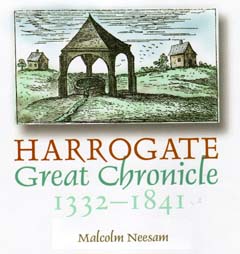 With such a grand place in social history, the Harrogate Great Chronicle is an appropriately impressive history of the resort from the 14th to the 19th centuries.
With such a grand place in social history, the Harrogate Great Chronicle is an appropriately impressive history of the resort from the 14th to the 19th centuries.
When it first arrived it was apparent that this was serious reading, although dipping in and out of this new book, as one does, elicited snippets of historical information that merely wetted the appetite for a more considered read. With 448 pages of text and illustrations, Malcolm Neesam’s masterpiece systematically plots the chronological evolution of Harrogate in great detail, using researched data interwoven with comment on the events and people who moulded the town. Much of the information has not previously been published and the 6 pages of acknowledgements give a clue to the research programme necessary to amass and then interpret the findings. Notes and references are given by chapter at the end, which is invaluable for scholars. There is also a useful index
One area of particular interest inevitably is the discovery and the naming of Harrogate as a spa. This we learn came about sometime after the discovery of the Tewit Well by a William Slingsby in 1571, when it was likened to the continental resort of that name. The term English Spa was first applied by Dr Timothy Bright in about 1596. Bright was personal physician to Queen Elizabeth I but mystery surrounds who Slingsby was. Various authors have confused Sir William Slingsby with the earlier Mr and a Captain William Slingsby. Neesam speedily deals with this issue in chapter four, stating that it was the plain Mr William Slingsby’s discovery that enabled the designation “spa” to be applied to Harrogate’s new healing spring. 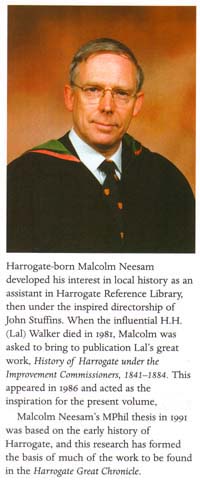 This was in spite of William Grainge as the author of “Memoir of the Life of Sir William Slingsby” in 1862 arguing the case for Sir William. Perhaps this will put an end to the mystery that surrounds this matter as these two great Harrogate historians lock swords for the final time?
This was in spite of William Grainge as the author of “Memoir of the Life of Sir William Slingsby” in 1862 arguing the case for Sir William. Perhaps this will put an end to the mystery that surrounds this matter as these two great Harrogate historians lock swords for the final time?
Another issue that is of topical interest is water bottling. Again this is an issue that Neesam authoritively addresses and in doing so succeeds in pushing back the date for the first Harrogate water bottling to circa 1630 (page 81). I am not sure about Neesam’s speculation that Harrogate may have been the first bottled water however; Malvern can claim to have evidence to suggest a slightly earlier date. Doubtless this issue will raise itself again in the future as spa historians delve into the provenance of their favoured localities.
Having explored the text, the reader of the Harrogate Great Chronicle then discovers that the volume is only part 1. Modern technology has resulted in an accompanying cd rom containing a mass of source and bibliographical material used in the preparation of the Harrogate Great Chronicle. This part 2 comprises primary as well as secondary sources and is therefore an invaluable aid to future researchers who may have difficulty in viewing the original material. Text references in the book lead you straight to the detailed source material on the cd. It also provides a partial archive that will back up the originals, should they be destroyed or lost in the future. Unlikely say some, but it was only a few years ago that Brighton Library had a disastrous flood that damaged forever their important collections.
In 100 years time I can see Neesam’s work being republished as a facsimile edition, just as William Grainge’s work of 1871 was in 1988. The Harrogate Great Chronicle is one of those erudite works that elevates local history from a retirement pursuit of the middle classes to scholarship of the highest level. The problem with all knowledge is that the more you know the more you realise you do not know. I am sure that the debate will go on, especially as more history of Harrogate is created daily. However the Harrogate Great Chronicle is not only one of those books that you inevitably end up putting the word “the” before to emphasise its importance, it is a significant stepping stone in evaluating Harrogate’s past from which the present town and a whole branch of international healthcare has evolved.
Dr Bruce Osborne, Spas Research Fellowship 7 January 2006.
Harrogate Great Chronicle (2005) Neesam M, Carnegie Publishing. Hard Back, 448 pp. 103 illustrations, 48 plans, with accompanying cd rom. Available direct from the publishers priced £25.00 (01524 840111) as well as all good bookshops.